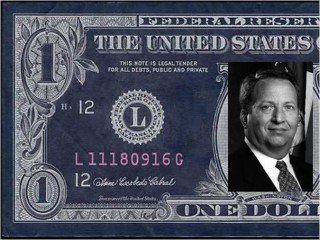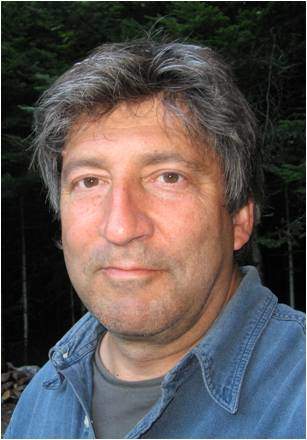The Negative Natural Interest Rate and Uneconomic Growth
by Herman Daly
In a recent speech to the International Monetary Fund, economist Larry Summers argued that since near-zero interest rates have not stimulated GDP growth sufficiently to reach full employment, we probably need a negative interest rate. By this, he means a negative monetary rate set by the Federal Reserve to equal the “natural” rate, which he believes is now negative. The natural rate, as Summers uses the term, means the rate that would equalize planned saving with planned investment, and thereby, as Keynes taught us, result in full employment. With near-zero monetary rates, current inflation already pushes us to a negative real rate of interest, but that is still insufficiently negative, in Summers’ view, to equalize planned investment with planned saving and thereby stimulate GDP growth sufficient for full employment. A negative interest rate is a stunning proposal, and it takes some effort to work out its implications.

GDP growth is actually making our economy poorer, unless we start to count real costs such as pollution and natural resource consumption. (Image: CC0, Credit: geralt).
Suppose for a moment that GDP growth, economic growth as we gratuitously call it, entails uneconomic growth by a more comprehensive measure of costs and benefits—that GDP growth has now begun to increase counted plus uncounted costs by more than counted plus uncounted benefits, making us inclusively and collectively poorer, not richer. If that is the case, and there are good reasons to believe that it is, would it not then be reasonable to expect, along with Summers, that the natural rate of interest is negative, and that maybe the monetary rate should be too? This is hard to imagine, but it means that savers would have to pay investors (and banks) to use the funds that they have saved, rather than investors and banks paying savers for the use of their money. To keep the GDP growing sufficiently to avoid unemployment we would need a growing monetary circular flow, which would require more investment, which, in turn, would only be forthcoming if the monetary interest rate were negative (i.e., if you lost less by investing your money than by holding it). A negative interest rate “makes sense” if the goal is to keep on increasing GDP even after it has begun to make us poorer at the margin—that is after growth has already pushed us beyond the optimal scale of the macro-economy relative to the containing ecosphere, and thereby become uneconomic.
A negative monetary interest rate means that citizens will spend rather than save, so savings will not be available to finance the investments that produce the GDP growth needed for full employment. The new money for investment comes from the Fed. Quantitative easing (money printing) is the source of new money. The faith is that an ever-expanding monetary circulation will pull the real economy along behind it, providing growth in real income and jobs as previously idle resources are employed. But the resulting GDP growth is now uneconomic because in the full world the “idle” resources are not really idle—they are providing vital ecosystem services. Redeploying these resources to GDP growth has environmental and social opportunity costs that are greater than production benefits. Although hyper-Keynesian macroeconomists do not believe this, the micro actors in the real economy experience the constraints of the full world, and consequently find it difficult to follow the unlimited growth recipe.
Summers (along with other mainstream growth economists), does not accept the concept of optimal scale of the macro-economy, nor the possibility of uneconomic growth in the sense that growth in resource throughput could reduce net wealth and wellbeing. Nevertheless, it is at least consistent with his view that the natural rate of interest is negative.
A positive interest rate restricts the total volume of investment but allocates it to the most productive projects. A negative interest rate increases volume, but allows investment in practically anything, increasing the probability that growth will be uneconomic. Shall we become hyper-Keynesians and push GDP growth to maintain full employment, even after growth has become uneconomic? Or shall we back off from growth and seek full employment by job sharing, distributive equity, and reallocation toward leisure and public goods?
Why would we allow growth to carry the macro-economy beyond the optimal scale? Because growth in GDP is considered the summum bonum, and it is heresy not to advocate increasing it. If increasing GDP makes us worse off we will not admit it but will adapt to the experience of increased scarcity by pushing GDP growth further. Non-growth is viewed as “stagnation,” not as a sensible steady-state adaptation to objective limits. Stimulating GDP growth by increasing consumption and investment, while cutting savings, is the only way that hyper-Keynesians can think of to serve the worthy goal of full employment. There really are other ways, and people really do need to save for security and old age, as well as for maintenance and replacement of the existing capital stock. Yet the Federal Reserve is being advised to penalize saving with a negative interest rate. The focus is on what the growth model requires, not on what people need.
A negative interest rate seems also to be the latest advice from Paul Krugman, who praises Summers’ insights. It is understandable from their viewpoint because in their vision the economy is not a subsystem, or if it is, it is infinitesimal relative to the total system. The economy can expand forever, either into the void or into a near-infinite environment. It does not grow into a finite ecosphere, and therefore has no optimal scale relative to any constraining and sustaining environment. Its aggregate growth incurs no opportunity cost and can never be uneconomic. Unfortunately, this tacit assumption of the growth model is seriously wrong.

Larry Summers and other growth-obsessed economists are calling for negative interest rates. (Author’s creation.)
Welcome to the full-world economy. In the old empty-world economy, assumed in the macro models of Summers and Krugman, growth always remains economic, so they advocate printing more and more dollars to expand the economy to take over ever more of the “unemployed” sources and sinks of the ecosystem. If a temporary liquidity trap or zero lower bound on interest rates keeps the new money from being spent, then low or even negative monetary interest rates will open the spending spigot. The empty world assumption guarantees that the newly expanded production will always be worth more than the natural wealth it displaces. But what may well have been true in yesterday’s empty world is no longer true in today’s full world.
This is an upsetting prospect for growth economists—growth is required for full employment, but growth now makes us collectively poorer. Without growth, we would have to cure poverty by redistributing wealth and stabilizing population, two political anathemas, and could only finance investment by reducing present consumption, a third anathema. There remains the microeconomic policy of reallocating the same GDP to a more efficient mix of products by internalizing external costs (getting prices right). While this certainly should be done, it is not macroeconomic growth as pursued by the Federal Reserve.
These painful choices could be avoided if only we were richer. So let’s just focus on getting richer. How? By growing the aggregate GDP, of course! What? You repeat that GDP growth is now uneconomic? That cannot possibly be right, they say. OK, that is an empirical question. Let’s separate costs from benefits in the existing GDP accounts and develop more inclusive measures of each, and then see which grows more as GDP grows. This has been done (ISEW, GPI, Ecological Footprint), and results support the uneconomic growth view. If growth economists think these studies were done badly they should do them better rather than ignore the issue.
The leftover Keynesians are correct in pointing out that there are unemployed labor and capital. But natural resources are fully employed, indeed overexploited, and the limiting factor in the full world is natural resources, not labor or capital as used to be the case in the empty world. Some growth economists think that the world is still empty. Others think there is no limiting factor —that capital is a good substitute for natural resources. This is wrong, as Nicholas Georgescu-Roegen has shown long ago. Capital funds and natural resource flows are complements, not substitutes, and the one in short supply is limiting. Increasing a non-limiting factor doesn’t help. Growth economists should know this.
Although the growthists think quantitative easing will stimulate demand, they are disappointed even in terms of their own model because the banks, who are supposed to lend the new money, encounter a “lack of bankable projects,” to use World Bank terminology. This, of course, should be expected in the new era of uneconomic growth. The new money, rather than calling forth new wealth by employing all these hypothetical idle resources from the empty world era, simply bid up existing asset prices in the full world. Most asset prices are not counted in the consumer price index, (not to mention the exclusion of food and energy) so economists unconvincingly claim that quantitative easing has not been inflationary, and therefore they can keep doing it. And even if it causes some inflation, that would help make the interest rate negative.
Aside from needed electronic transaction balances, people would not keep money in the bank if the interest rate were negative. To make them do so, the alternative of cash would basically have to be eliminated, and all money would be electronic bank deposits. This intensifies central bank control and the specter of “bail-ins” (confiscations of deposits) as occurred in Cyprus. Even as distrust of money increases, people will not immediately revert to barter, in spite of negative interest rates. Barter is so inconvenient that money remains more efficient even if it loses value at a rapid rate, as we have seen in several hyperinflations. But transaction balances will be minimized, and speculative and store-of value-balances will be diverted to real estate, gold, works of art, tulip bulbs, Bitcoins, and beanie babies, creating speculative bubbles. But not to worry, say Summers and Krugman, bubbles are necessary, if regrettable, means to boost spending and growth in the era of newly recognized negative natural interest rates—and still unrecognized uneconomic growth.

Factors of uneconomic growth include negative interest rates and below-subsistence wages. (Image: CC0, Credit: Dan Smith).
A bright silver lining to this cloud of confusion is that the recognition of a negative natural interest rate may be the prelude to the recognition of the underlying uneconomic growth as its cause. For sure this has not yet happened because so far the negative natural interest rate is seen as a reason to push growth with a negative monetary interest rate, rather than as a signal that growth has become a losing game. But such a realization is a reasonable hope. Perhaps a step in this direction is Summers’ suggestion that the old Alvin Hansen thesis of secular stagnation might deserve a new look.
The logic that suggests negative interest also suggests negative wages as a further means of increasing investment by lowering costs. To maintain full employment via GDP growth, not only must the interest rate now be negative, but wages should become negative as well. No one yet advocates negative wages because subsistence provides an inconvenient lower positive bound below which workers die. On this “other side of the looking glass,” the logic of uneconomic growth pushes us in the direction of a negative “natural” wage, just as with a negative “natural” rate of interest. So we artificially lower the wage costs to “job creators” by subsidizing below-subsistence wages with food stamps, housing subsidies, and unpaid internships. Negative interest rates also subsidize investment in job-replacing capital equipment, further lowering wages. Negative interest rates and below-subsistence wages, further subsidize the uneconomic growth that gave rise to them in the first place.
The leftover Keynesians tell us, reasonably enough, that paying people to dig holes in the ground and then fill them up, is better than leaving them unemployed with no income. But paying people to deplete and pollute the Creation on which our lives and welfare ultimately depend, in order to expand the macro-economy beyond its optimal or even sustainable scale, is surely worse than just giving them a minimum income, and some leisure time, in exchange for doing no harm.
An artificial monetary rate of interest forced down by quantitative easing to equal a negative natural rate of interest resulting from uneconomic growth is not a solution. It is just baling wire and duct tape. But it is all that even our best and brightest economists can come up with as long as they are imprisoned in the empty world growth model. The way out of this trap is to recognize that the growth era is over and that instead of forcing growth into the uneconomic territory, we must seek to maintain a steady state economy at something approximating the optimal scale. Since we have overshot the optimal scale of the macro-economy, this will require a period of retrenchment to a reduced level, accompanied by much more equal sharing, frugality, and efficiency. Sharing means putting limits on the range of inequality that we permit; it has huge moral and social benefits, even if politically difficult. Frugality means using less resource throughput; it results in less depletion and pollution and more recycling and efficiency. Efficiency means squeezing more life-support and want-satisfaction from a given throughput by technological advance and by improvement in our ethical priorities. Economists need to replace the Keynesian-neoclassical growth synthesis with a new version of the classical stationary state.
 Herman Daly is CASSE Chief Economist, Professor Emeritus (University of Maryland), and past World Bank senior economist.
Herman Daly is CASSE Chief Economist, Professor Emeritus (University of Maryland), and past World Bank senior economist.


Dear Mr. Daly,
Your article, above, is interesting, as is the general concept of this website that unending economic growth is not possible, logical or sustainable. Kudos for that. However, both this site and your piece miss the vital heart of the matter: this society, as are all Western (Menace) societies, is an extreme Capitalist plutocracy, thus, the ‘us’ to whom you refer so often, is really just ‘them,’ a tiny subset of the population – ‘1%’ of ‘the 1%.’
Of even more importance, however, is a correct understanding of what constitutes ‘the US Economy.’ As I wrote in my (still unpublished) own article of 18Oct2013, ‘the US Economy,’ ever since W. Bush was awarded the White House, has become something new, a thing well-beyond the traditional real economies based on agriculture, manufacturing, mining and services: today, ‘the US Economy’ is mostly a ‘Grand Theft-Engine,’ in which the US Fed ‘prints’ (electronically) new US Dollars, mostly in secret, which have real purchasing power as the whole world is the ‘Dollar Zone’ – a consequence of the absurd, holdover status the Dollar retains as the world’s international reserve currency.
Further, ‘the US Economy,’ actually all Western (Menace) economies, and all Western (Menace) empire-states are unstable, unsustainable, and are short-timers, each inexorably locked into ever-tightening death-spirals. Do you really believe, for example, that in the next decade, when China, alone, will be more than twice the entire West combined, and more than four times The US Empire, that anything Western will be tolerated? Not to mention that by then, bankrupt Western regimes will need to steal another $20 trillion, or so, to keep afloat their now-failed ‘financial institutions,’ and to keep importing the ruling-circles’ high-end ‘Western way of life.’
In the coming Post-Western World, which will be here by 2030 or 2025, and maybe even by 2020, such intelligent concepts are ‘sustainable economies’ will be appreciated and sought after by the then-leading societies, none of which will be Western. Pretty soon thereafter, no one ever will have heard of idiot, mendacious Westerners such as ‘General Theory’-created John Maynard Keynes – he certainly was no Einstein, a humane Human being whose name most-likely never will be forgotten.
I would be delighted to send you my article, and others, if you would like. Please let me know.
Very sincerely yours,
Herbert Salit
Los Angeles, CA
herbsalit@roadrunner.com
Dear Mr. Salit,
I totally agree with your point of view. I am new in the matter and started to read a lot about it. This point of view of the global economy is opening my eyes and helps me realize where we are moving towards.
Day by day we face that intolerable greed from people and companies and see all the destruction of resources and nature; all the increasing damage we do to our environment, and we are so close to the point of no return.
Sincerely,
Carolina Prado
We salute the Daly News and honor Herman Daly on the Wall of Fame at Growth Bias Busted for exemplary commentary on the subject of economic growth. Thank you, CASSE. Keep up the good work! http://www.growthbiasbusted.org/entry/the-negative-natural-interest-rate-and-uneconomic-growth